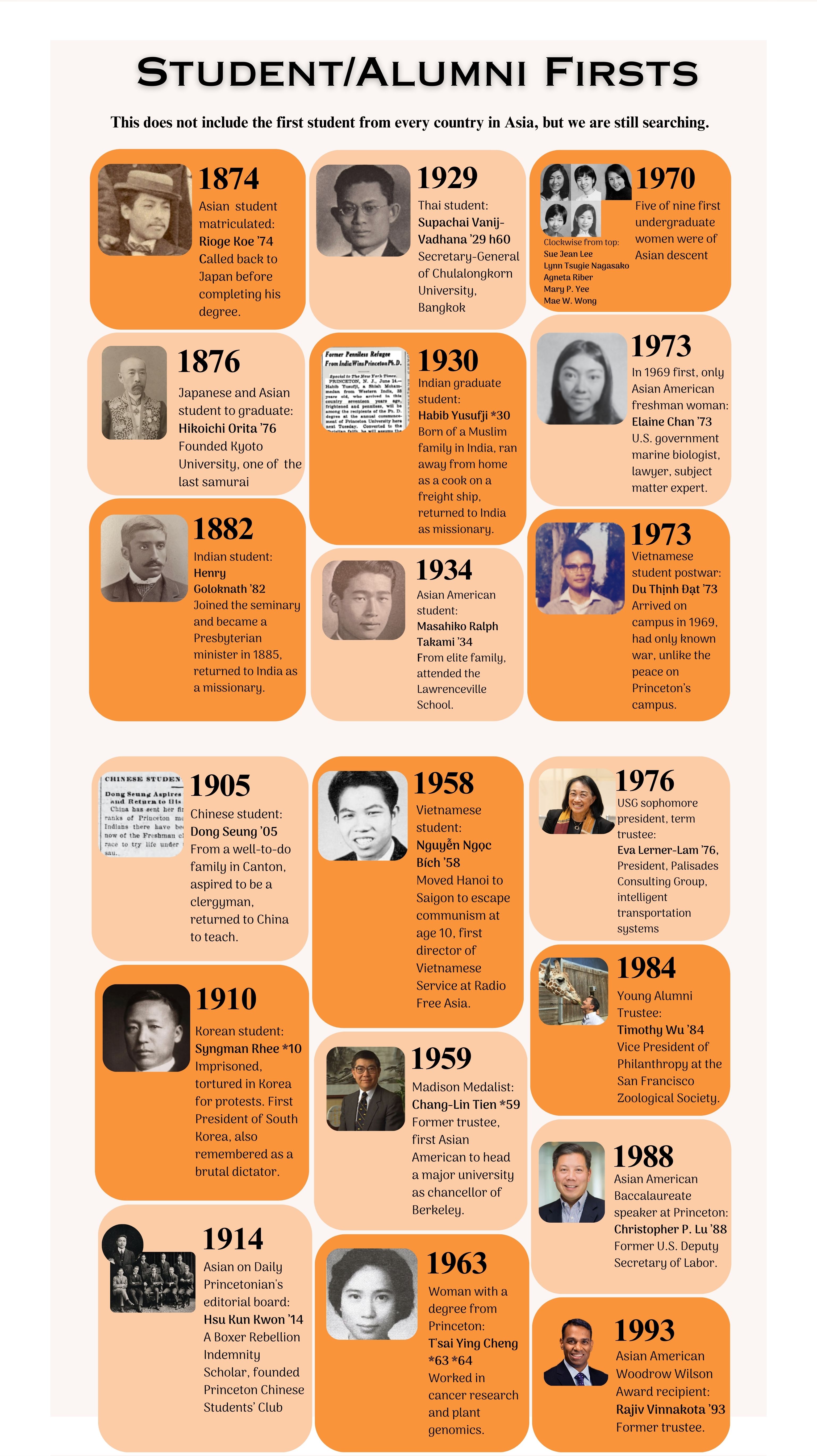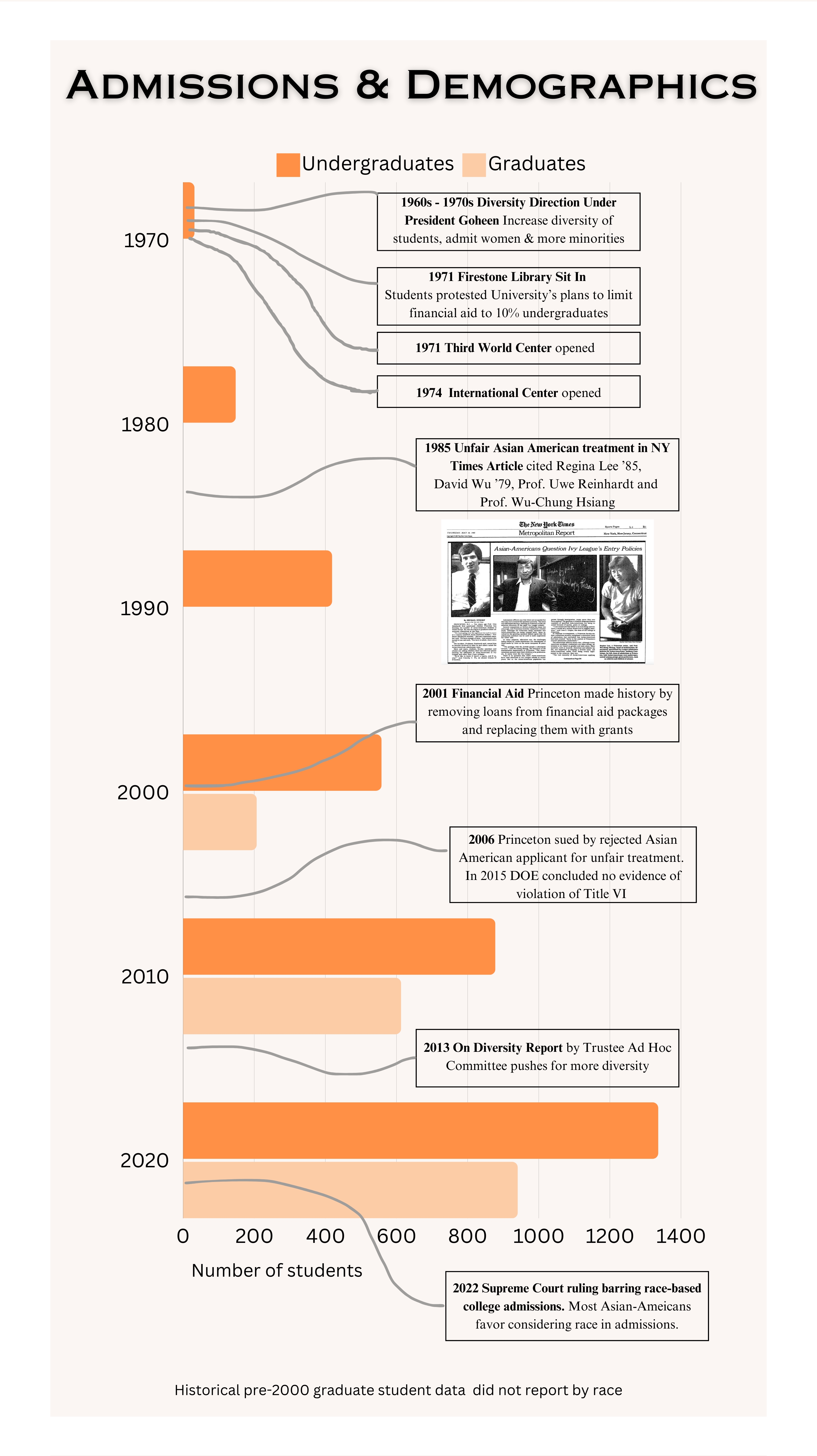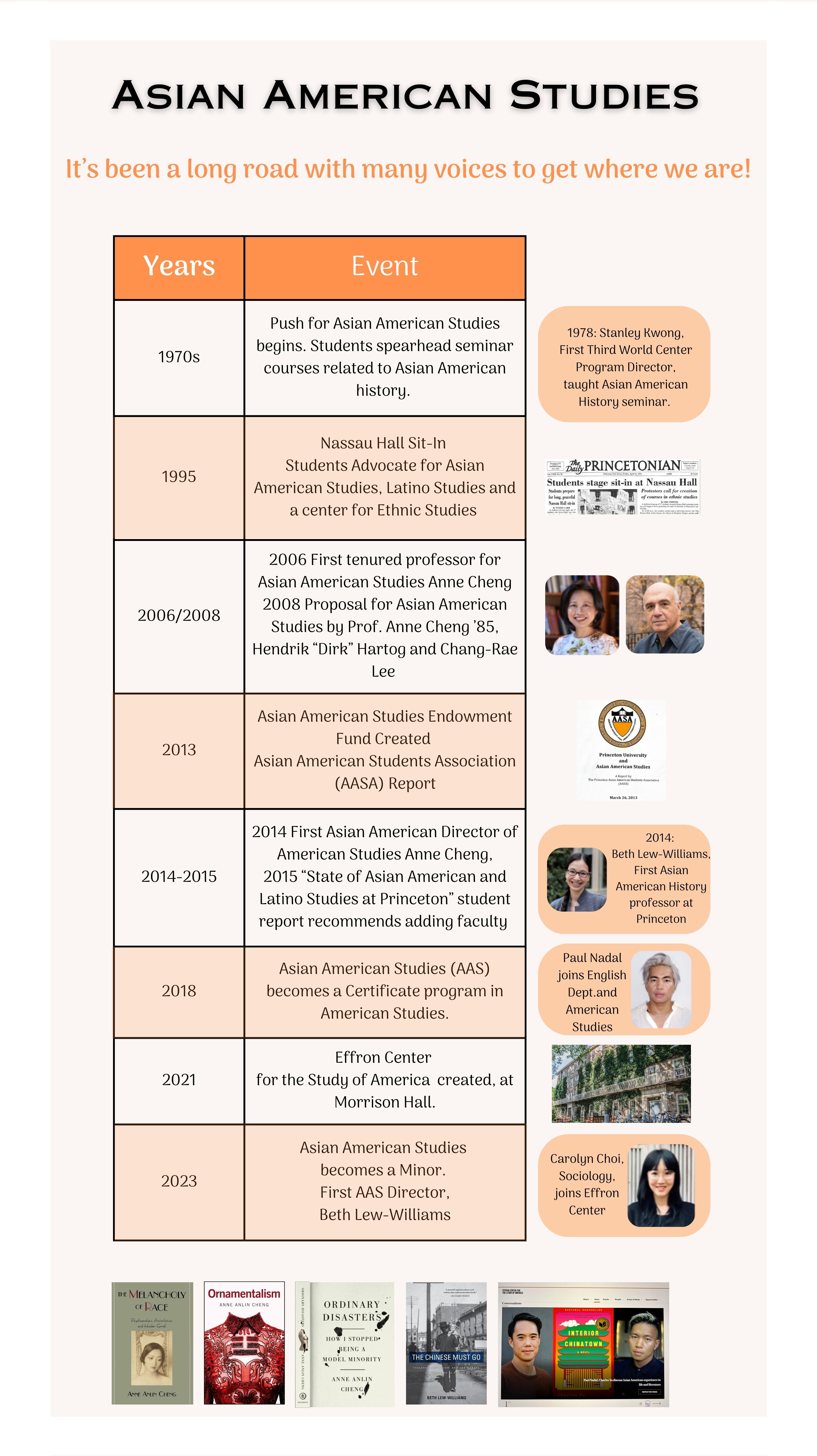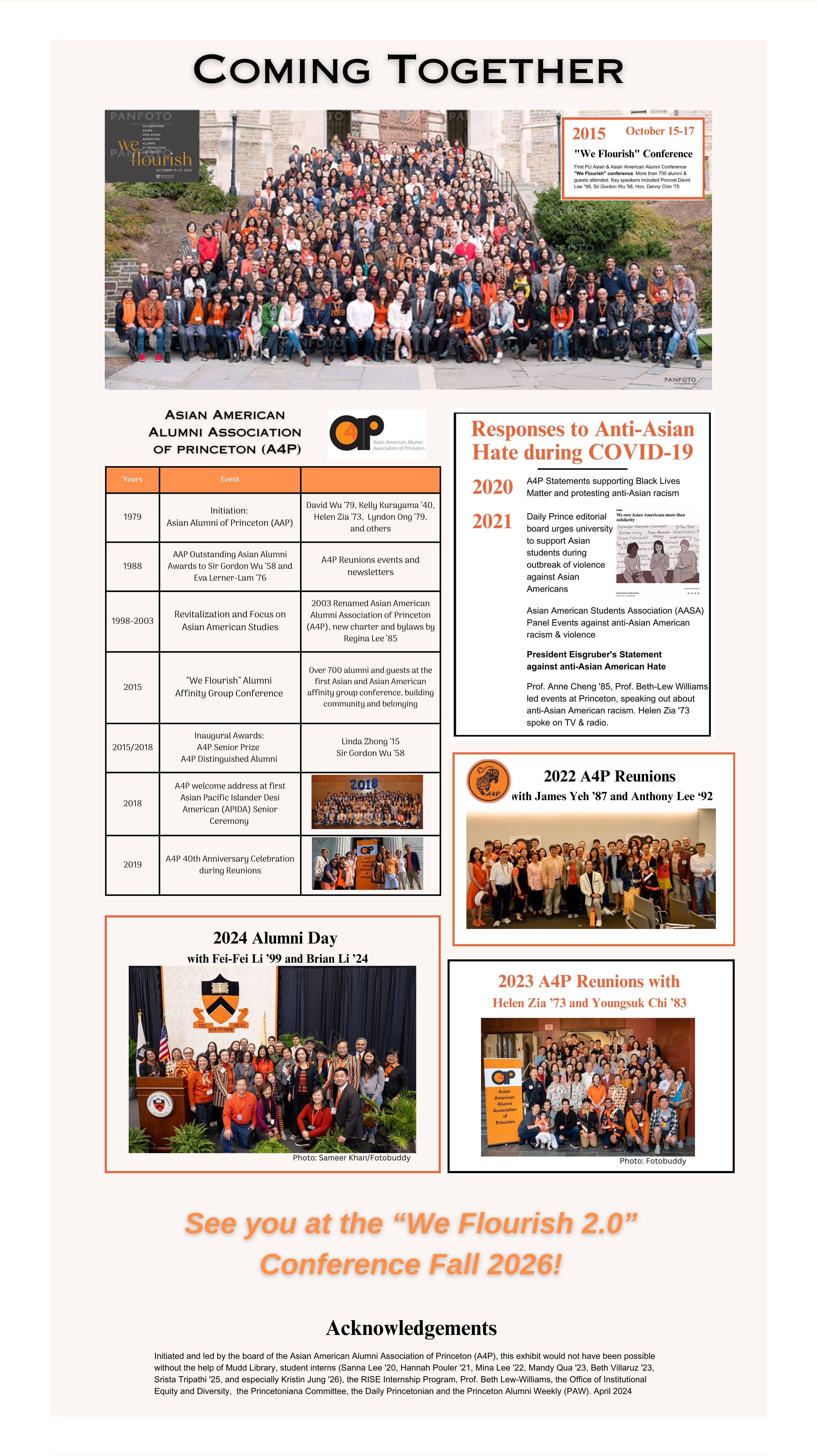The "150 Years of Asian and Asian American Students at Princeton" history exhibit was led by Princeton alumni for the Princeton University community, a joint effort of the Asian American Alumni Association of Princeton (A4P) and the Princetoniana Museum. The intent is to give a long-term perspective, an opportunity for reflection and appreciation for the challenges and accomplishments of initially Asian students only and later also of Asian American students at Princeton with the backdrop of geopolitics and socioeconomic disparities. This Princetoniana Museum version of the exhibit is expanded from the physical exhibit shown at Frist Campus Center during Spring 2024 (see The Daily Princetonian article). The list of notable alumni highlighted is not comprehensive and we hope there will be future versions with even more.

The Vitrine Display in Frist
Introduction

Panel 1, click for expanded image
In developing the “150-years of Asian and Asian American students at Princeton”, we uncovered a rich and complex multigenerational history impacted by geopolitics, domestic policy, and socioeconomics. This project, a collaboration of A4P, Mudd Library and the Princetoniana Committee, builds off the University’s 2019 digital walking tour “Stories of Asians and Asian Americans at Princeton”.
The timeline highlights key dates of government-imposed boundaries and their gradual lifting due to geopolitics and domestic policy. During the first 50 years, given limitations to immigration and citizenship imposed by the United States' Chinese Exclusion Act, almost all Asian students at Princeton were international. Many students were sponsored by their governments and hailed from well-to-do families, but many others struggled to get funding to attend. Most early international students returned home after their Princeton education, many remaining in touch with their alma mater.
Student/Alumni Firsts

Panel 2, click for expanded image
“Asians” and “Asian-Americans” are each broad terms encompassing a wide array of cultures, countries and people. We show the first students from Japan, India, China, Thailand, Korea and Vietnam, as well students who were pioneers on campus (first Asian Daily Prince editorial board member, first Asian and Asian American undergraduate and graduate students, first Asian heritage women, and as alumni (e.g., first Baccalaureate speaker, first Madison Medalist and first Woodrow Wilson Award recipients).
Our Student/Alumni Firsts page is not all-encompassing - in fact, we have continued to discover new information since our exhibit’s creation.
Admissions and Demographics

Panel 3, click for expanded image
Asian students were first admitted under President James McCosh in limited numbers. During 1960s - 1970s, President Goheen’s diversity direction welcomed women and more minorities into the Princeton community. Asian and Asian American students alike are now integrated within many Princeton eating clubs and organizations, and we’d like to highlight some of the most influential groups and individuals who shaped Asian and Asian-American campus life.
Although Stanley Kwong and Paula Chow were not students of Princeton University, they influenced many students, particularly Asian and Asian American students.
The Third World Center (1971): The Third World Center became a thriving community for many students of minority backgrounds. Stanley Kwong, the TWC’s first program director, was instrumental in transforming it into a welcoming space for the school’s students of color. The Third World Center has since evolved into the Carl A. Fields Center.
International Center (1974): Co-founded in 1974 and incorporated into the Office of Undergraduate Student Life in 1978, the International Center provides specialized support to international students for legal and cultural adjustment to American life. Paula Chow, co-founder and long-time director from 1975 to 2010, harnessed her prior experiences as an immigrant to create a welcoming space for all students. Since renamed the Davis International Center, it is currently located in the Simpson Building and proudly continues serving the Princeton community.
Asian American Studies

Panel 4, click for expanded image
The implementation and continuous expansion of Princeton’s Asian American Studies (ASA) has been a decades-long effort distinguishing the unique history and struggles of this community. It’s been a long path since the first Third World Center Program Director, Stanley Kwong, taught an Asian American History seminar in 1978. The 1995 Nassau Sit-In advocated for a center for Ethnic Studies, with student-authored white papers highlighting the necessity of Asian American Studies at Princeton over 2013-2015. An Asian American Studies Endowment Fund was created in 2013, largely funded by alumni.
The ASA certificate was established in 2018. After the 2021 launch of the Effron Center for the Study of America, the ASA minor was launched in 2023. The program has not yet reached its critical mass of six faculty with ASA teaching commitments, highlighting the importance of further discussion and advocacy.
Anne Cheng 1985: Professor of English and Princeton’s first tenured professor in Asian American studies (2006). Cheng is author of three books on the politics of race and aesthetics and a new book of personal essays Ordinary Disasters: How I Stopped Being a Model Minority (2024).
Beth Lew-Williams: Professor of History and the first director of Princeton’s Program in Asian American Studies. Her research, including The Chinese Must Go: Violence, Exclusion, and the Making of the Alien in America, tackles the societal and political repercussions of racial violence and exclusion.
Notable Alumni

Panel 5, click for expanded image
150 years of Asian and Asian American students have produced alumni of diverse backgrounds, Princeton experiences, and career pathways.
We further commemorate recipients of the A4P Distinguished Alumni Award, inaugurated in 2018 with Sir Gordon Wu ‘58 at his 60th Reunion. These individuals have demonstrated outstanding service to the Princeton University’s Asian/Asian American community and the Asian/Asian American community at large: Gordon Chang ‘70, William Fung ‘70, Franklin Odo ‘61 *75, Maria Ressa ‘86, James Yeh ‘82, Helen Zia ‘73, Youngsuk Chi ‘83, Jaime Ayala ‘84 and Fei-Fei Li ‘99.
Go here for a more detailed listing of notable Asian and Asian American alumni.
Coming Together

Panel 6, click for expanded image
A4P was initiated in 1979 as the “Asian Alumni of Princeton” (AAP), renaming itself in 2003 to its current name of the “Asian American Alumni Association of Princeton”. For the past 45 years, A4P has celebrated the continuous growth of Princeton’s Asian and Asian American communities.
We encourage alumni engagement of all types, from virtual A4P Community Hours and career development opportunities to international collaboration with affinity groups and regional alumni associations. “We Flourish”, held from October 15-17, 2015, was the first alumni conference celebrating Asian and Asian American alumni, bringing over 700 alums back to Old Nassau. As older alums marveled at Princeton’s improving diversity and cultural inclusivity, our inaugural “We Flourish” reinvigorated the senses of belonging and hope that we continue to nurture.
With rediscoveries of long-lost student stories, hundreds of new Asian and Asian American students enrolling in Princeton each year, and countering anti-Asian discrimination during the 2020s, it's an exciting time to be an Asian or Asian American Princetonian as we celebrate, support and advocate for our students, alumni and community.
Acknowledgements
This Princeton history project was initiated and led by the board of the Asian American Alumni Association of Princeton (A4P), in particular, A4P Board Members Nancy Lin ‘77, Doug Chin ‘83, Chris Loh ‘86, and Anu Vedantham *94 championed and provided perspectives, stories and resources.
Associate Provost for Institutional Diversity and Inclusion Shawn Maxam sponsored the 2019 “Stories of Asians and Asian Americans at Princeton” digital walking tour, provided access to numerous Princeton reference materials, and provided funding for the Frist exhibit panels.
Valencia Johnson, Project Archivist for Student Life at Mudd Library, helped procure primary archival resources for the project.
Professor Beth Lew-Williams provided the Key Dates timeline on the first panel.
Jean Hendry *80 of the Princetoniana Committee provided helpful guidance and expertise for developing the physical exhibit panels.
The Daily Princetonian and the Princeton Alumni Weekly (PAW) were both critical information sources.
Lastly, the exhibit would not have been possible without the help of student interns Sanna Lee ‘20, Hannah Pouler ‘21, Mina Lee ‘22, Mandy Qua ‘23 Beth Villaruz ‘23, Srista Tripathi ‘25, and especially Kristin Jung ‘26 who designed and created the Canva panels and Andrew Park ‘26 who expanded this exhibit for the Princetoniana digital museum.

